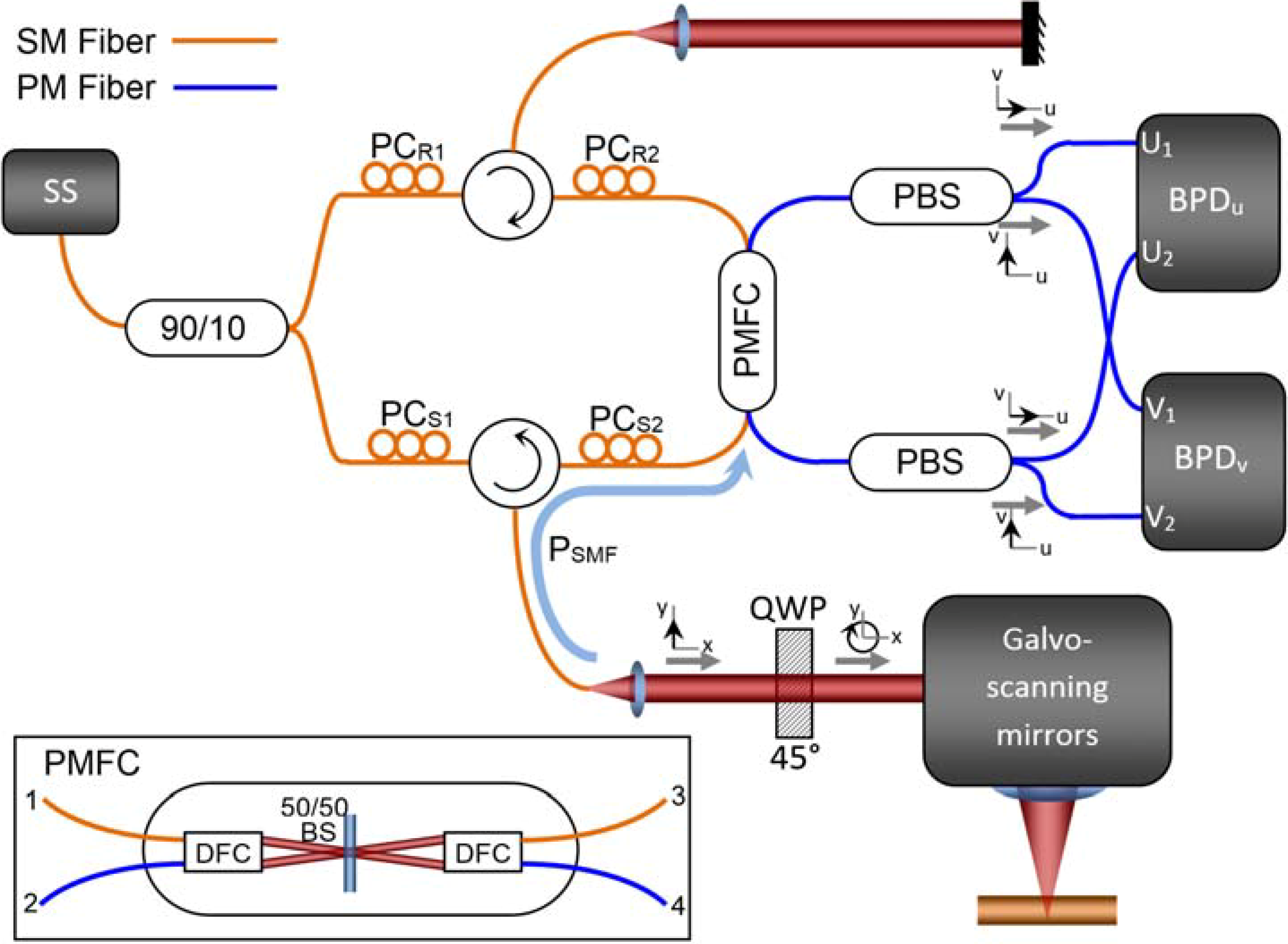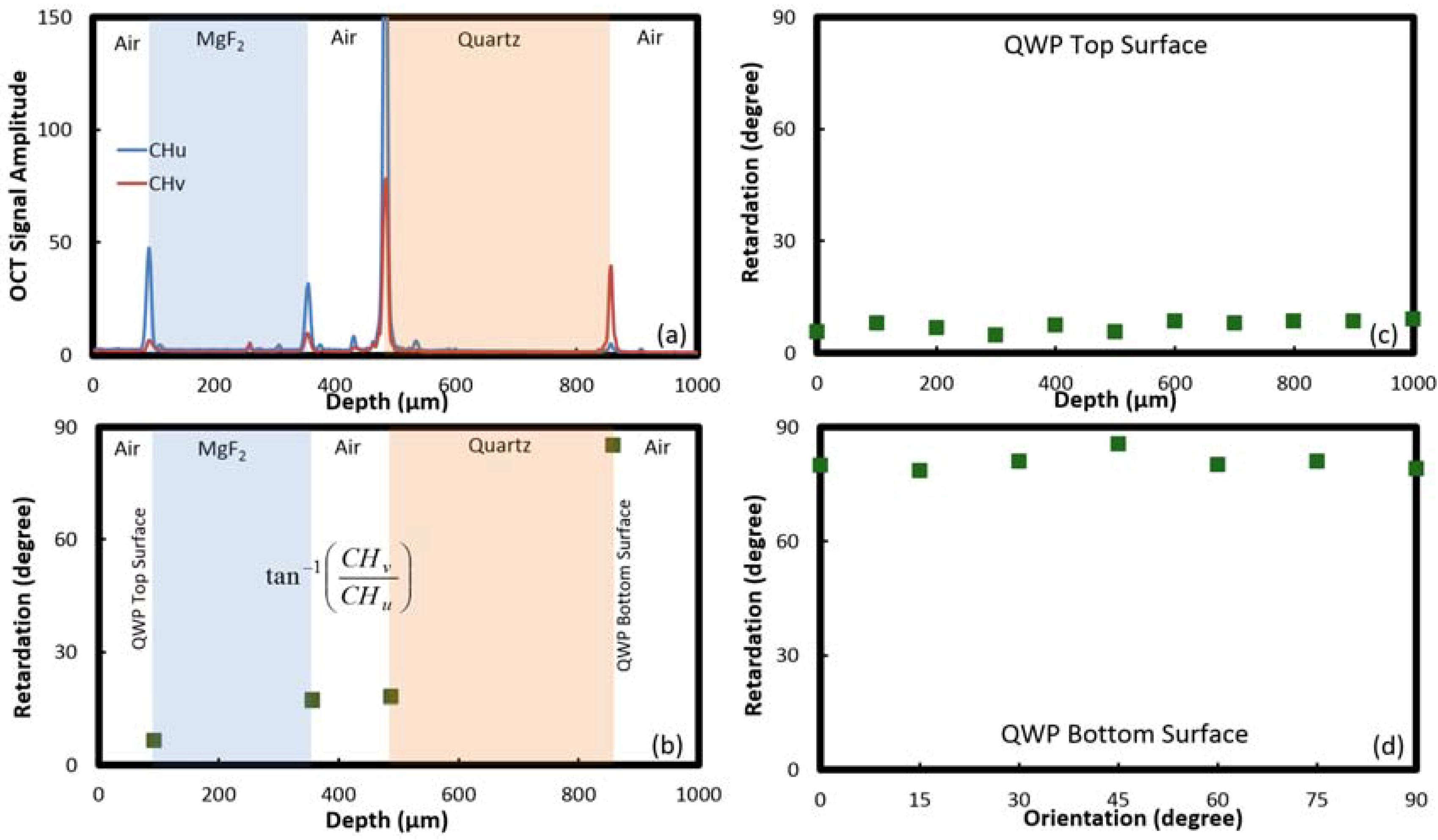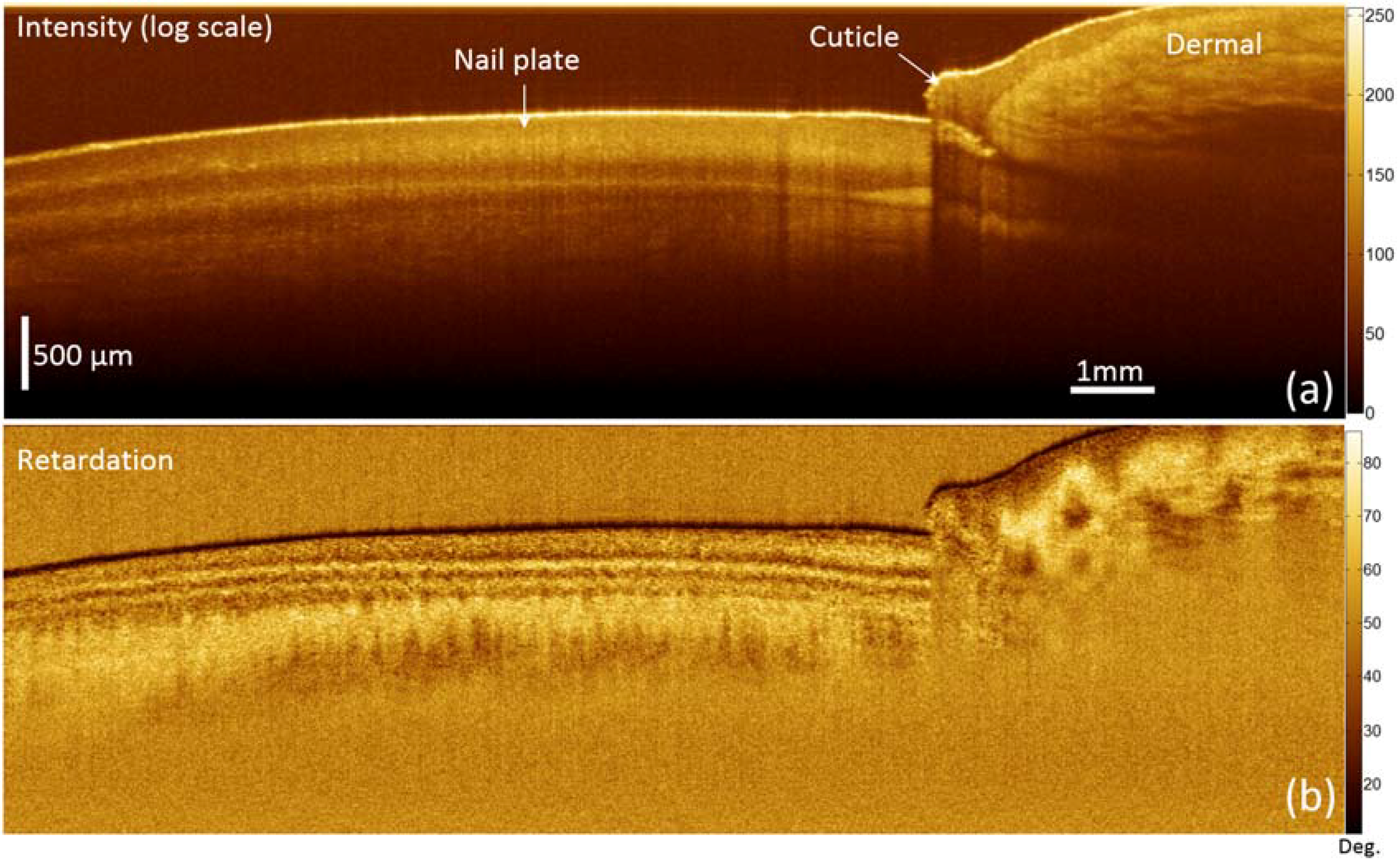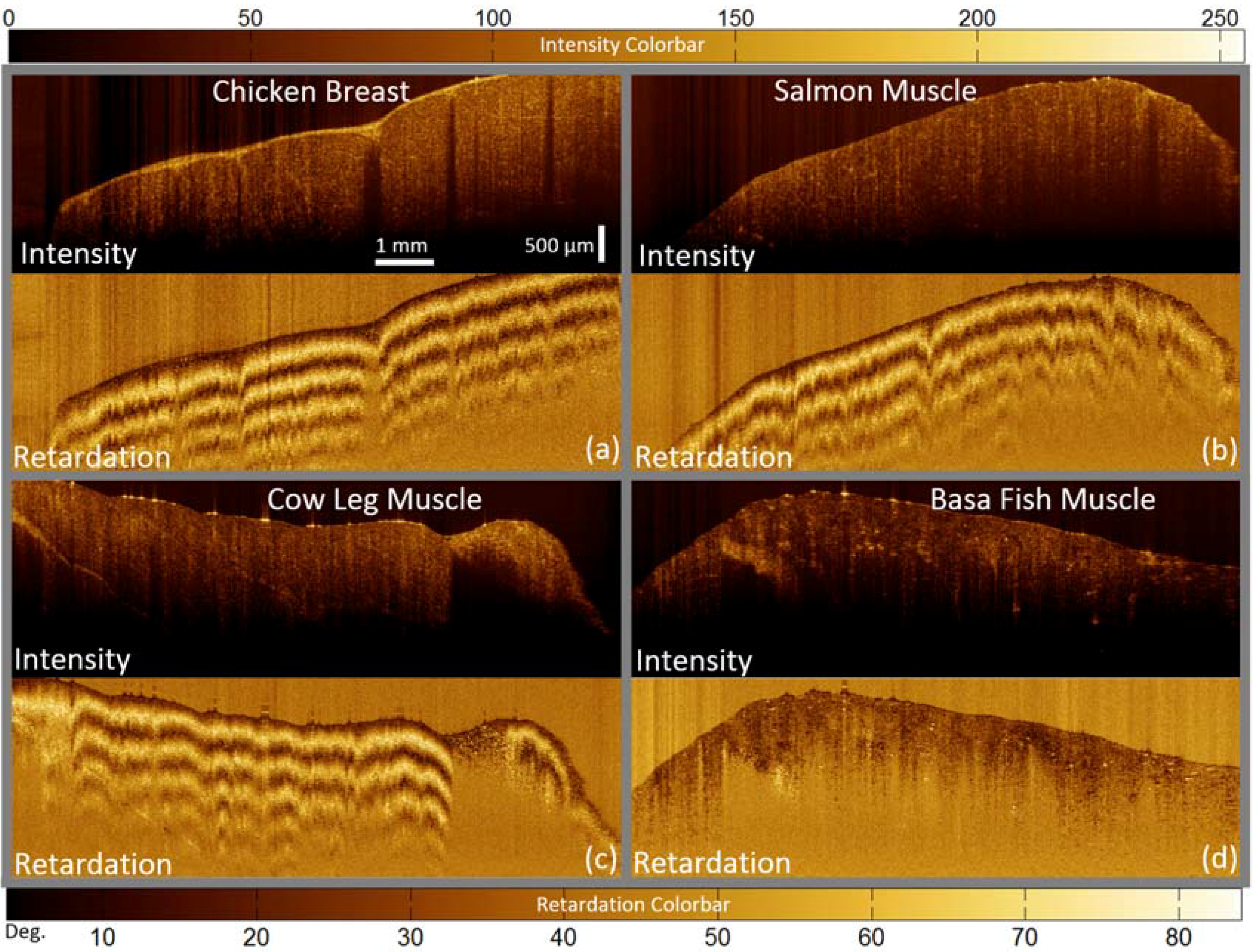Fiber-Based Polarization Diversity Detection for Polarization-Sensitive Optical Coherence Tomography
Abstract
:1. Introduction
2. Materials and Methods
2.1. Imaging System

2.2. System Calibration
2.3. Analytic Framework




3. Results and Discussion



4. Conclusions
Acknowledgments
Author Contributions
Conflict of Interest
References
- Huang, D.; Swanson, E.A.; Lin, C.P.; Schuman, J.S.; Stinson, W.G.; Chang, W.; Hee, M.R.; Flotte, T.; Gregory, K.; Puliafito, C.A.; et al. Optical coherence tomography. Science 1991, 254, 1178–1181. [Google Scholar] [PubMed]
- Fujimoto, J.G.; Brezinski, M.E.; Tearney, G.J.; Boppart, S.A.; Bouma, B.; Hee, M.R.; Southern, J.F.; Swanson, E.A. Optical biopsy and imaging using optical coherence tomography. Nat. Med. 1995, 1, 970–971. [Google Scholar] [CrossRef] [PubMed]
- Tearney, G.J.; Brezinski, M.E.; Bouma, B.E.; Boppart, S.A.; Pitris, C.; Southern, J.F.; Fujimoto, J.G. In vivo endoscopic optical biopsy with optical coherence tomography. Science 1997, 276, 2037–2039. [Google Scholar] [PubMed]
- Park, B.H.; Saxer, C.; Srinivas, S.M.; Nelson, J.S. In vivo burn depth determination by high-speed fiber-based polarization sensitive optical coherence tomography. J. Biomed. Opt. 2001, 6, 474–479. [Google Scholar] [CrossRef] [PubMed]
- Nadkarni, S.K.; Pierce, M.C.; Park, B.H.; de Boer, J.F.; Whittaker, P.; Bouma, B.E.; Bressner, J.E.; Halpern, E.; Houser, S.L.; Tearney, G.J. Measurement of collagen and smooth muscle cell content in atherosclerotic plaques using polarization-sensitive optical coherence tomography. J. Am. Coll. Cardiol. 2007, 49, 1474–1481. [Google Scholar] [CrossRef] [PubMed]
- Burns, J.A.; Kim, K.H.; de Boer, J.F.; Anderson, R.R.; Zeitels, S.M. Polarization-sensitive optical coherence tomography imaging of benign and malignant laryngeal lesions: An in vivo study. Otolaryngol Head Neck Surg. 2011, 145, 91–99. [Google Scholar]
- Braaf, B.; Vermeer, K.A.; de Groot, M.; Vienola, K.V.; de Boer, J.F. Fiber-based polarization-sensitive OCT of human retina with correction of system polarization distortions. Biomed. Opt. Express 2014, 5, 2736–2758. [Google Scholar] [PubMed]
- Zotter, S.; Pircher, M.; Torzicky, T.; Baumann, B.; Yoshida, H.; Hirose, F.; Roberts, P.; Ritter, M.; Schütze, C.; Götzinger, E.; et al. Large-field high-speed polarization sensitive spectral domain OCT and its applications in ophthalmology. Biomed. Opt. Express 2012, 3, 2720–2732. [Google Scholar] [PubMed]
- Hee, M.R.; Huang, D.; Swanson, E.; Fujimoto, J.G. Polarization-sensitive low-coherence reflectometer for birefringence characterization and ranging. J. Opt. Am. B 1992, 9, 903–908. [Google Scholar]
- de Boer, J.F.; Milner, T.E.; Van Gemert, M.J.C.; Nelson, J.S. Two-dimensional birefringence imaging in biological tissue by polarization-sensitive optical coherence tomography. Opt. Lett. 1997, 22, 934–936. [Google Scholar] [PubMed]
- de Boer, J.F.; Srinivas, S.M.; Malekafzali, A.; Chen, Z.; Nelson, J.S. Imaging thermally damaged tissue by polarization sensitive optical coherence tomography. Opt. Express 1998, 3, 212–218. [Google Scholar] [PubMed]
- Everett, M.J.; Schoenenberger, K.; Colston, B.W., Jr.; Da Silva, L.B. Birefringence characterization of biological tissue by use of optical coherence tomography. Opt. Lett. 1998, 23, 228–230. [Google Scholar] [PubMed]
- de Boer, J.F.; Milner, T.E.; Nelson, J.S. Determination of the depth-resolved Stokes parameters of the light backscattered from turbid media by use of the polarization-sensitive optical coherence tomography. Opt. Lett. 1999, 24, 300–302. [Google Scholar] [PubMed]
- Hitzenberger, C.K.; Gӧtzinger, E.; Sticker, M.; Pircher, M.; Fercher, A.F. Measurement and imaging of birefringence and optic axis orientation by phase resolved polarization sensitive optical coherence tomography. Opt. Express 2001, 9, 780–790. [Google Scholar] [PubMed]
- Yao, G.; Wang, V. Two-dimensional depth-resolved Muller matrix characterization of biological tissue by optical coherence tomography. Opt. Lett. 1999, 24, 537–539. [Google Scholar] [PubMed]
- Jiao, S.; Yao, G.; Wang, L.V. Depth-resolved two-dimensional Stokes vectors of backscattered light and Mueller matrices of biological tissue measured with optical coherence tomography. Appl. Opt. 2000, 39, 6318–6324. [Google Scholar] [PubMed]
- Saxer, C.E.; de Boer, J.F.; Park, B.H.; Zhao, Y.; Chen, Z.; Nelson, J.S. High-speed fiber-based polarization-sensitive optical coherence tomography of in vivo human skin. Opt. Lett. 2000, 25, 1355–1357. [Google Scholar] [CrossRef] [PubMed]
- Pierce, M.C.; Park, B.H.; Cense, B.; de Boer, J.F. Simultaneous intensity, birefringence, and flow measurements with high-speed fiber-based optical coherence tomography. Opt. Lett. 2002, 27, 1534–1536. [Google Scholar] [PubMed]
- Park, B.H.; Pierce, M.C.; Cense, B.; de Boer, J.F. Real-time multi-functional optical coherence tomography. Opt. Express 2003, 11, 782–793. [Google Scholar] [CrossRef] [PubMed]
- Park, B.H.; Pierce, M.C.; Cense, B.; de Boer, J.F. Jones matrix analysis for a polarization-sensitive optical coherence tomography system using fiber-optic components. Opt. Lett. 2004, 29, 2512–2514. [Google Scholar] [CrossRef] [PubMed]
- Yamanari, M.; Makita, S.; Yasuno, Y. Polarization-sensitive swept-source optical coherence tomography with continuous source polarization modulation. Opt. Express 2008, 16, 5892–5906. [Google Scholar] [PubMed]
- Villinger, M.; Zhang, E.Z.; Nadkarni, S.K.; Oh, W.Y.; Vakoc, B.J.; Bouma, B.E. Spectral binning for mitigation of polarization mode dispersion artifacts in catheter-based optical frequency domain imaging. Opt. Express 2013, 21, 16353–16369. [Google Scholar] [PubMed]
- Kim, K.H.; Park, B.H.; Tu, Y.; Hasan, T.; Lee, B.; Li, J.; de Boer, J.F. Polarization-sensitive optical frequency domain imaging based on unpolarized light. Opt. Express 2011, 19, 552–561. [Google Scholar] [PubMed]
- Oh, W.Y.; Yun, S.H.; Vakoc, B.J.; Shishkov, M.; Desjardins, A.E.; Park, B.H.; de Boer, J.F.; Tearney, G.J.; Bouma, B.E. High-speed polarization sensitive optical frequency domain imaging with frequency multiplexing. Opt. Express 2008, 16, 1096–1103. [Google Scholar] [PubMed]
- Baumann, B.; Choi, W.J.; Potsaid, B.; Huang, D.; Duker, J.S.; Fujimoto, J.G. Swept-source/Fourier domain polarization sensitive optical coherence tomography with a passive polarization delay unit. Opt. Express 2012, 20, 10229–10241. [Google Scholar]
- Ju, M.J.; Hong, Y.J.; Makita, S.; Lim, Y.; Kurokawa, K.; Duan, L.; Miura, M.; Tang, S.; Yasuno, Y. Advanced multicontrast Jones matrix optical coherence tomography for Doppler and polarization sensitive imaging. Opt. Express 2013, 21, 19412–19436. [Google Scholar] [PubMed]
- Rollins, M.; Izatt, J.A. Optimal interferometer designs for optical coherence tomography. Opt. Lett. 1999, 24, 1484–1486. [Google Scholar] [PubMed]
- Pierce, M.; Shishkov, M.; Park, B.H.; Nassif, N.A.; Bouma, B.E.; Tearney, G.J.; de Boer, J.F. Effects of sample arm motion in the endoscopic polarization-sensitive optical coherence tomography. Opt. Express 2005, 13, 5739–5749. [Google Scholar] [PubMed]
- Fu, X.; Wang, Z.; Wang, H.; Wang, Y.T.; Jenkins, M.W.; Rollins, A.M. Fiber-optic catheter-based polarization-sensitive OCT for radio-frequency ablation monitoring. Opt. Lett. 2014, 38, 5066–5069. [Google Scholar]
- Wang, Z.; Lee, H.C.; Ahsen, O.O.; Lee, B.K.; Choi, W.J.; Potsaid, B.; Liu, J.; Jayaraman, V.; Cable, A.; Kraus, M.F.; et al. Depth-encoded all-fiber swept-source polarization sensitive OCT. Biomed. Opt. Express 2014, 5, 2931–2949. [Google Scholar]
- Lin, H.; Kao, M.C.; Lai, C.M.; Huang, J.C.; Kuo, W.C. All fiber optics circular-state swept source polarization-sensitive optical coherence tomography. J. Biomed. Opt. 2013, 19, 021110. [Google Scholar]
- Davé, D.P.; Akkin, T.; Milner, T.E. Polarization-maintaining fiber-based optical low-coherence reflectometer for characterization and ranging of birefringence. Opt. Lett. 2003, 28, 1775–1777. [Google Scholar] [PubMed]
- Al-Qaisi, M.K.; Akkin, T. Polarization-sensitive optical coherence tomography based on polarization-maintaining fibers and frequency multiplexing. Opt. Express 2008, 16, 13032–13041. [Google Scholar] [PubMed]
- Gӧtzinger, E.; Baumann, B.; Pircher, M.; Hitzenberger, C.K. Polarization maintaining fiber based ultra-high resolution spectral domain polarization sensitive optical coherence tomography. Opt. Express 2009, 17, 22704–22717. [Google Scholar] [PubMed]
- Bonesi, M.; Sattmann, H.; Torzicky, T.; Zotter, S.; Baumann, B.; Pircher, M.; Gӧtzinger, E.; Eigenwillig, C.; Wieser, W.; Huber, R.; Hitzenberger, C.K. High-speed polarization sensitive optical coherence tomography scan engine based on Fourier domain mode locked laser. Biomed. Opt. Express 2012, 3, 2987–3000. [Google Scholar] [PubMed]
- Lu, Z.; Kasaragod, D.; Matcher, S.J. Conical scan polarization-sensitive optical coherence tomography. Biomed. Opt. Express 2014, 5, 763–773. [Google Scholar] [PubMed]
- Yun, S.H.; Tearney, G.J.; Vadoc, B.J.; Shishkov, M.; Oh, W.Y.; Desjardins, A.E.; Suter, M.J.; Chan, R.C.; Evans, J.A.; Jang, I.K.; et al. Comprehensive volumetric optical microscopy in vivo. Nat. Med. 2006, 12, 1429–1433. [Google Scholar] [PubMed]
- Lee, A.M.D.; Pahlevaninezhad, H.; Yang, V.X.D.; Lam, S.; MacAulay, C.; Lane, P.M. Fiber-based polarization diversity detection for rotary probe optical coherence tomography. Opt. Lett. 2014, 39, 3638–3641. [Google Scholar] [PubMed]
- Yun, S.H.; Boudoux, C.; Tearney, G.J.; Bouma, B.E. High-speed wavelength-swept semiconductor laser with a polygon-scanner-based wavelength filter. Opt. Lett. 2003, 28, 1981–1983. [Google Scholar] [CrossRef] [PubMed]
- Schoenenbeger, K.; Colston, B.W.; Maitland, D.J., Jr.; Da Silva, L.B.; Everett, M.J. Mapping of birefringence and thermal damage in tissue by use of polarization-sensitive optical coherence tomography. Appl. Opt. 1998, 37, 6026–6036. [Google Scholar] [PubMed]
- Yariv, A.; Yeh, P. Photonics: Optical electronics and modern communications, 6th ed.; Oxford University Press: New York, NY, USA; pp. 51–53.
© 2014 by the authors; licensee MDPI, Basel, Switzerland. This article is an open access article distributed under the terms and conditions of the Creative Commons Attribution license (http://creativecommons.org/licenses/by/4.0/).
Share and Cite
Pahlevaninezhad, H.; Lee, A.M.D.; Cahill, L.; Lam, S.; MacAulay, C.; Lane, P. Fiber-Based Polarization Diversity Detection for Polarization-Sensitive Optical Coherence Tomography. Photonics 2014, 1, 283-295. https://doi.org/10.3390/photonics1040283
Pahlevaninezhad H, Lee AMD, Cahill L, Lam S, MacAulay C, Lane P. Fiber-Based Polarization Diversity Detection for Polarization-Sensitive Optical Coherence Tomography. Photonics. 2014; 1(4):283-295. https://doi.org/10.3390/photonics1040283
Chicago/Turabian StylePahlevaninezhad, Hamid, Anthony M. D. Lee, Lucas Cahill, Stephen Lam, Calum MacAulay, and Pierre Lane. 2014. "Fiber-Based Polarization Diversity Detection for Polarization-Sensitive Optical Coherence Tomography" Photonics 1, no. 4: 283-295. https://doi.org/10.3390/photonics1040283



